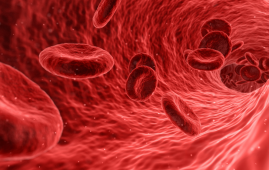

Most racial and ethnic communities are unaware of food allergies. However, a new Northwestern Medicine study—the first population-based food allergy study in the United States to investigate racial and ethnic differences across all age groups—shows why this should be the case.
According to the current study, the frequency of food allergy is higher among Hispanic, non-Hispanic Black, and Asian people of all ages. Food allergy is also lowest in homes earning more above $150,000 per year.
The report was published in JAMA Network Open on June 14th.
According to the authors, there has been a scarcity of population-based data on food allergy among racial and ethnic groups in the United States. The majority of past research has similarly focused on children.
“Food allergies are not frequently talked about impacting racial and ethnic communities,” said study corresponding author Dr. Ruchi Gupta. “It’s not on the radar. But we now know it does impact them more, and it’s important to improve awareness.
“It is also critical to improve access to diagnosis and treatments for food allergy. It is an exciting time with new treatments, and making sure they reach racial and ethnic minorities who have higher rates of food allergy is essential.”
Gupta is a professor of pediatrics at Northwestern University Feinberg School of Medicine and the director of the Center for Food Allergy and Asthma Research. She also works as a doctor at Ann & Robert H. Lurie Children’s Hospital of Chicago.
New treatments include oral, epicutaneous (on the skin), and sublingual (under the tongue) immunotherapy, all of which desensitize the immune system to the allergen. New biologics, which stop the allergic reaction cascade, are another therapy option, according to Gupta.
When Gupta started researching food allergy research two decades ago, no one knew there were discrepancies.
“We now know that racial and ethnic minorities as well as underserved populations often do not get to an allergist for diagnosis,” Gupta said. They have the symptoms of food allergy but the access to get to a specialist has been challenging, and the fact that there were no treatments led them to just try and avoid the food.
However, the current study demonstrates that food allergies, which affect 11% of adults and 8% of children in the United States, impact people of all races and ethnicities.
The following are some of the study’s findings:
Food allergies are most common in Asian (10.5%), Hispanic (10.6%), and non-Hispanic Black people of all ages (10.6%).
Non-Hispanic Black people with food allergies were the most likely to have several food allergies (50.6%).
The lowest incidence of serious food allergy reactions were found in Asian and non-Hispanic white people.
Food allergies were most common in households earning more than $150,000 per year (8.3%).
This study reports on outcomes such as common food allergens, emergency room visits for food-allergic responses, and epinephrine administration, in addition to the prevalence of food allergy. It also takes into account socioeconomic level, which is linked to the occurrence of food allergies.
According to the study, an ensemble of allergy disorders all show similar patterns in terms of who is impacted. The ensemble is part of an atopic march of allergic disorders that emerge during infancy and childhood, including eczema, food allergies, allergic rhinitis, and asthma.
“There haven’t been enough genetic changes over the last 30 to 40 years to explain this grouping of allergic conditions,” said study co-author Christopher Warren, an epidemiologist and an assistant professor of preventive medicine at Northwestern University Feinberg School of Medicine. “Clearly, something has changed in the environment. It behooves us to figure out what are those changes, and how can we reverse them or add interventions to mitigate them.”
“It Is an exciting time in food allergy with new diagnostics, prevention and treatments,” Gupta said. “Our goal is to see these numbers start to come down in the next 30 to 40 years.”
A population-based survey was performed online and by phone to a nationally representative sample of the US population for the study. More than 50,000 households were polled, yielding replies from nearly 80,000 people.
more recommended stories
 Fat-Regulating Enzyme Offers New Target for Obesity
Fat-Regulating Enzyme Offers New Target for ObesityKey Highlights (Quick Summary) Researchers identified.
 Spatial Computing Explains How Brain Organizes Cognition
Spatial Computing Explains How Brain Organizes CognitionKey Takeaways (Quick Summary) MIT researchers.
 Gestational Diabetes Risk Identified by Blood Metabolites
Gestational Diabetes Risk Identified by Blood MetabolitesKey Takeaways (Quick Summary for Clinicians).
 Phage Therapy Study Reveals RNA-Based Infection Control
Phage Therapy Study Reveals RNA-Based Infection ControlKey Takeaways (Quick Summary) Researchers uncovered.
 Pelvic Floor Disorders: Treatable Yet Often Ignored
Pelvic Floor Disorders: Treatable Yet Often IgnoredKey Takeaways (Quick Summary) Pelvic floor.
 Urine-Based microRNA Aging Clock Predicts Biological Age
Urine-Based microRNA Aging Clock Predicts Biological AgeKey Takeaways (Quick Summary) Researchers developed.
 Circadian Control of Neutrophils in Myocardial Infarction
Circadian Control of Neutrophils in Myocardial InfarctionKey Takeaways for HCPs Neutrophil activity.
 E-Cigarette Use and Heart Attack Risk in Former Smokers
E-Cigarette Use and Heart Attack Risk in Former SmokersKey Takeaways for Clinicians and Nurses.
 36-Week Pre-eclampsia Screening May Reduce Term Risk
36-Week Pre-eclampsia Screening May Reduce Term RiskA New Preventive Strategy for Term.
 Cardiovascular Risk and Sudden Cardiac Death in Diabetes
Cardiovascular Risk and Sudden Cardiac Death in DiabetesRising Sudden Cardiac Death (SCD) Risk.

Leave a Comment